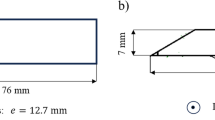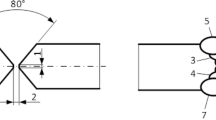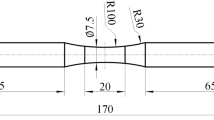Conclusion
The increased impact-fatigue strength of cast steel in comparison with forged is caused by the character of fatigue crack origin and development in the cast metal. In the cast steel the time of crack origin is longer then in the wrought as the result of relaxation processes and grain refinement occurring in service.
Similar content being viewed by others
Literature cited
Yu. A. Geller, Tool Steels [in Russian], Metallurgiya, Moscow (1975).
A. I. Kashirin, "The question of the strength of the cutting portion of a tool in cutting of difficult to machine steels," in: Friction and Wear in Cutting of Metals [in Russian], Mashgiz, Moscow (1955), pp. 5–13.
G. L. Khaet, "Increasing the life of sintered carbide cutters," Mashinostroitel', No. 1, 20–21 (1971).
Ya. B. Fridman, The Mechanical Properties of Metals (Third Edition Revised and Supplemented in Two Parts) [in Russian], Part II: Mechanical Tests. Design Strength, Mashinostroenie, Moscow (1974).
I. A. Revis and G. A. Lebedev, The Structure and Properties of Cast Cutting Tools, Second Edition Revised and Supplemented [in Russian], Mashinostroenie, Leningrad Branch, Leningrad (1972).
I. A. Revis, A. M. Levinson, and V. S. Naletov, "The use of deep freezing in the production of cast tools without hardening," in: The Use of Cold in Tool Production [in Russian], Leningrad. Dom Nauch. Tekh. Prop. (1977), pp. 11–19.
N. M. Yashkin et al., "A machine for high temperature impact-fatigue tests of metals," Zavod. Lab., No. 11, 1410–1411 (1977).
Yu. A. Bagaryatskii (ed.), X-Ray Diffractometry in Physical Metallurgy [in Russian], Metallurgizdat, Moscow (1961).
V. S. Ivanova and V. F. Terent'ev, The Nature of the Fatigue of Metals [in Russian], Metallurgiya, Moscow (1976).
Additional information
Tula Planning and Design Technology Institute for Combine Building "Proektin.". Translated from Metallovedenie i Termicheskaya Obrabotka Metallov, No. 4, pp. 10–12, April, 1986.
Rights and permissions
About this article
Cite this article
Cherkasov, V.E., Yakshin, N.M. & Kavitskii, I.M. The impact-fatigue strength of cast and wrought high-speed steels. Met Sci Heat Treat 28, 240–244 (1986). https://doi.org/10.1007/BF00707646
Issue Date:
DOI: https://doi.org/10.1007/BF00707646




